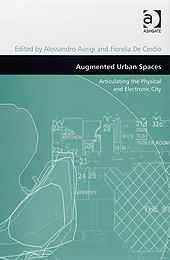AR and cities go well together. One of the reasons is that, by comparison with rural landscapes, the environment is quite well documented (with 3D models, photographs, maps, etc). A second reason is that some features of the environment, like the buildings, are stationary while others, like the people and cars, are moving. Another reason for these to fit naturally together is that there's a lot more information that can be associated with places and things than those of us passing through can see with our "naked" eyes. There's also a mutual desire: people –those who are moving about in urban landscapes, and those who have information about the spaces–need or want to make these connections more visible and more meaningful.
The applications for AR in cities are numerous. Sometimes the value of the AR experience is just to have fun. Let's imagine playing a game that involves the physical world and information encoded with (or developed in real time for use with) a building's surface. Mobile Projection Unit (MPU) Labs is an Australian start up doing some really interesting work that demonstrates this principle. They've taken the concept of the popular mobile game "Snake" and, by combining it with a small projector, smartphone and the real world, made something new. Here's the text from their minimalist web page:
"When ‘Snake the Planet!” is projected onto buildings, each level is generated individually and based on the selected facade. Windows, door frames, pipes and signs all become boundaries and obstacles in the game. Shapes and pixels collide with these boundaries like real objects. The multi-player mode lets players intentionally block each other’s path in order to destroy the opponent."
Besides this text, there's a quick motivational "statement" by one of the designers (this does not play in the page for me, but click on vimeo logo to open it):
And this 2 minute video clip of the experience in action:
I'd like to take this out for a test drive. Does anyone know these guys?

